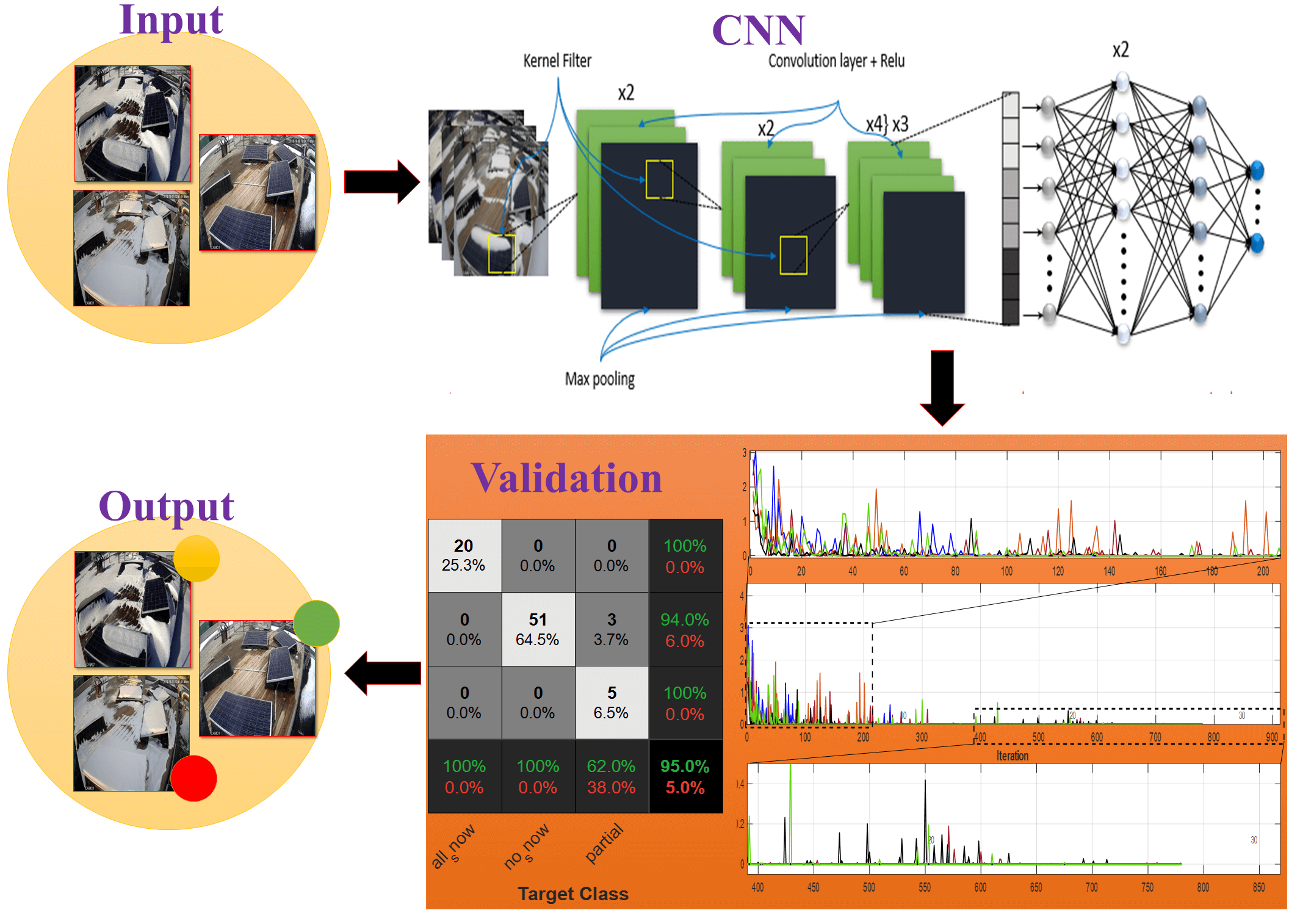 Open Access
Open Access
ARTICLE
Automated Classification of Snow-Covered Solar Panel Surfaces Based on Deep Learning Approaches
1
Department of Electrical and Electronics Engineering, Karabuk University, Karabuk, 78100, Turkey
2
Department of Computer Engineering, Istinye University, Istanbul, 34303, Turkey
3
College of Engineering and Technology, American University of the Middle East, Egaila, 54200, Kuwait
* Corresponding Author: Abdullah Ahmed Al-Dulaimi. Email:
Computer Modeling in Engineering & Sciences 2023, 136(3), 2291-2319. https://doi.org/10.32604/cmes.2023.026065
Received 13 August 2022; Accepted 23 November 2022; Issue published 09 March 2023
Abstract
Recently, the demand for renewable energy has increased due to its environmental and economic needs. Solar panels are the mainstay for dealing with solar energy and converting it into another form of usable energy. Solar panels work under suitable climatic conditions that allow the light photons to access the solar cells, as any blocking of sunlight on these cells causes a halt in the panels work and restricts the carry of these photons. Thus, the panels are unable to work under these conditions. A layer of snow forms on the solar panels due to snowfall in areas with low temperatures. Therefore, it causes an insulating layer on solar panels and the inability to produce electrical energy. The detection of snow-covered solar panels is crucial, as it allows us the opportunity to remove snow using some heating techniques more efficiently and restore the photovoltaics system to proper operation. This paper presents five deep learning models, -16,
-16,  -19,
-19,  ESNET-18, ESNET-50, and
ESNET-18, ESNET-50, and  ESNET-101, which are
used for the recognition and classification of solar panel images. In this paper, two different cases were applied;
the first case is performed on the original dataset without trying any kind of preprocessing, and the second case
is extreme climate conditions and simulated by generating motion noise. Furthermore, the dataset was replicated
using the upsampling technique in order to handle the unbalancing issue. The conducted dataset is divided into
three different categories, namely; all_snow, no_snow, and partial snow. The five models are trained, validated, and
tested on this dataset under the same conditions 60% training, 20% validation, and testing 20% for both cases.
The accuracy of the models has been compared and verified to distinguish and classify the processed dataset. The
accuracy results in the first case show that the compared models
ESNET-101, which are
used for the recognition and classification of solar panel images. In this paper, two different cases were applied;
the first case is performed on the original dataset without trying any kind of preprocessing, and the second case
is extreme climate conditions and simulated by generating motion noise. Furthermore, the dataset was replicated
using the upsampling technique in order to handle the unbalancing issue. The conducted dataset is divided into
three different categories, namely; all_snow, no_snow, and partial snow. The five models are trained, validated, and
tested on this dataset under the same conditions 60% training, 20% validation, and testing 20% for both cases.
The accuracy of the models has been compared and verified to distinguish and classify the processed dataset. The
accuracy results in the first case show that the compared models  -16,
-16,  -19,
-19,  ESNET-18, and
ESNET-18, and  ESNET-50
give 0.9592, while
ESNET-50
give 0.9592, while  ESNET-101 gives 0.9694. In the second case, the models outperformed their counterparts in
the first case by evaluating performance, where the accuracy results reached 1.00, 0.9545, 0.9888, 1.00. and 1.00
for
ESNET-101 gives 0.9694. In the second case, the models outperformed their counterparts in
the first case by evaluating performance, where the accuracy results reached 1.00, 0.9545, 0.9888, 1.00. and 1.00
for  -16,
-16,  -19,
-19,  ESNET-18 and
ESNET-18 and  ESNET-50, respectively. Consequently, we conclude that the second case
models outperformed their peers.
ESNET-50, respectively. Consequently, we conclude that the second case
models outperformed their peers. Graphic Abstract

Keywords
Cite This Article
 Copyright © 2023 The Author(s). Published by Tech Science Press.
Copyright © 2023 The Author(s). Published by Tech Science Press.This work is licensed under a Creative Commons Attribution 4.0 International License , which permits unrestricted use, distribution, and reproduction in any medium, provided the original work is properly cited.


 Submit a Paper
Submit a Paper Propose a Special lssue
Propose a Special lssue View Full Text
View Full Text Download PDF
Download PDF Downloads
Downloads
 Citation Tools
Citation Tools